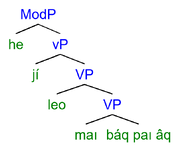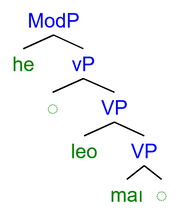Verb form, noun form: Difference between revisions
mNo edit summary |
(mention &Ps and FocusPs) Tags: Mobile edit Mobile web edit Advanced mobile edit |
||
| Line 1: | Line 1: | ||
We shall use the terms '''verblike''' and '''nounlike''' to refer to any strings of words that can function as “verbs” and “nouns” respectively. Namely, we’ll define | We shall use the terms '''verblike''' and '''nounlike''' to refer to any strings of words that can function as “verbs” and “nouns” respectively. Namely, we’ll define | ||
; verblikes: [[atomic verb|single verb words]] ({{t|toa}}, {{t|bụfoaq}}), [[serial verb]]s without arguments ({{t|dua maı}}, {{t|fuı tua mara}}), and special verb forms like [[predicatizer]]s ({{t| | ; verblikes: [[atomic verb|single verb words]] ({{t|toa}}, {{t|bụfoaq}}), [[serial verb]]s without arguments ({{t|dua maı}}, {{t|fuı tua mara}}), and special verb forms like [[predicatizer]]s ({{t|po jí}}) or [[quote]]s ({{t|shu ‹kası›}}) or [[ë|{{t|ë}}-phrases]] ({{t|ë tı súq ní}}) {{TODO|on the fence about whether this should include verbs with “prefilled” slots, i.e., object incorporation – {{t|choaı sâ nuı}}}}; finally including [[conjunction]]s ({{t|de ra fıe}}) and [[focus]]ed versions ({{t|kụloı}}) of those | ||
; nounlikes: [[determiner phrase]]s ({{t|cáo}}, {{t|ké paı mara}}), [[pronoun]]s ({{t|máq}}, {{t|hụ́la}}), and [[complementizer phrase|subclause]]s ({{t|ꝡä tı súq ní}}, {{t|lä nuaobo báq shıaq jâ}}) | ; nounlikes: [[determiner phrase]]s ({{t|cáo}}, {{t|ké paı mara}}), [[pronoun]]s ({{t|máq}}, {{t|hụ́la}}), and [[complementizer phrase|subclause]]s ({{t|ꝡä tı súq ní}}, {{t|lä nuaobo báq shıaq jâ}}); finally including conjunctions ({{t|pío de róı é fıe shía}}) and focused versions ({{t|tó báq lue}}) of those | ||
with the following idea in mind: | with the following idea in mind: | ||
Revision as of 10:49, 6 December 2023
We shall use the terms verblike and nounlike to refer to any strings of words that can function as “verbs” and “nouns” respectively. Namely, we’ll define
- verblikes
- single verb words (toa, bụfoaq), serial verbs without arguments (dua maı, fuı tua mara), and special verb forms like predicatizers (po jí) or quotes (shu ‹kası›) or ë-phrases (ë tı súq ní) on the fence about whether this should include verbs with “prefilled” slots, i.e., object incorporation – choaı sâ nuı; finally including conjunctions (de ra fıe) and focused versions (kụloı) of those
- nounlikes
- determiner phrases (cáo, ké paı mara), pronouns (máq, hụ́la), and subclauses (ꝡä tı súq ní, lä nuaobo báq shıaq jâ); finally including conjunctions (pío de róı é fıe shía) and focused versions (tó báq lue) of those
with the following idea in mind:
- clause ≔ verblike + zero or more nounlikes
This reflects the way we think about the composition of clauses, also minding the fact that the grammar puts the verblike at the very front and all the nounlikes after it in one sequence. It also saves us from the confusion.
The confusion
There are multiple layers of abstraction in play, and confusing them eventually leads to confusion. Let’s enumerate the layers with the example sentence He leo maı jí báq paı âq da I try to love my friends:

"he leo maı"; rather, those three words are scattered across the tree and intermingled with determiner phrases. This is why we can’t call he leo maı a verb phrase with a clean conscience.- At the phonetic/textual level, we have strings of text (or sounds) that are conceptualized as verb-like or noun-like phrase-like things. This is where we identify verblikes and nounlikes.
- We think of the string
"he leo maı"as a binary “verb” or “predicate” followed by two “arguments”,"jí"and"báq paı âq". We innately associate these fragments with “predicates” or “entities” at a pre-syntactic level.- You should be alarmed by the amount of scarequotes in this bullet point.
- We think of the string
- At the syntactic level, we have phrases, such as verb phrases, determiner phrases and similar. These are continuous trees of nested phrases, but the phonetic/textual content they represent is intermingled in a perhaps confusing way (a linguistic process known as movement sets everything back into place, giving
"he leo maı"an illusion of continuity).- The problem here is that verb phrase isn’t a very intuitive concept to grasp or manipulate.
"he leo maı"from before becomes: a fragment of a modality phrase (he) and two fragments of verb phrases (leo without its object and maı without its object). The full verb phrases in the example are discontinuous (peek at the diagram on the right): maı … báq paı âq, leo maı … báq paı âq, and finally leo maı jí báq paı âq."leo maı"does not correspond to any one verb phrase, but fragments of four verb phrases torn out of a so-called verbal complex and stitched together to give an illusion of contiguousness. - Similarly when nounlikes are concerned, no one type of syntactic phrase corresponds to them: there are determiner phrases, complementizer phrases, but also focus phrases (kú jí), coordination phrases (jí róı súq), …. The list goes on. One could theoretically refer to them all collectively as “phrases acting nominally”, but this does not roll off the tongue whatsoever.
- The problem here is that verb phrase isn’t a very intuitive concept to grasp or manipulate.
- At the semantic/denotational level, there are unary predicates/functions applied to various types of arguments.
- Here, in turn, we find that not only has
"leo maı"ever corresponded to one “predicate”, even though we like to colloquially think of it as a “verb” with an effective arity of 2 and the definition ___ tries to love ___. Also, the actual denotation of the entire verbal complex is much grosser than a binary function, lol.
- Here, in turn, we find that not only has
To recap: you could think of Toaq as a pipeline that takes a string "he leo maı jí báq paı âq" to a tree, and then to a logical form. We often find the most comfort talking about the strings as though they were parts of trees or even the trees themselves, and as though they were simplistic predicates that applied to a minimal amount of arguments in a neat way. In other words, we like to equivocate – and because of this, referring to verblikes as predicates or verb phrases, for instance, is only temporary relief for the learner before they dive into the deep syntax or (god forbid) the semantics and find that nothing that they’ve learned corresponds to what verb phrases and predicates actually look like.
So the real purpose of saying verblike instead of, say, verb phrase is not to use deep syntax terms to describe (and teach) surface-level Toaq. We want to match simple explanations with equally simple terms while remaining correct, and this is the solution we’re taking – save for pulling random Toaq roots out of our hat (like Lojban does with sumti and selbri and about everything else under the sun).
Other options considered or to consider
- We already say adverbial – why not then nominal, verbal?
- Verb form, noun form?
